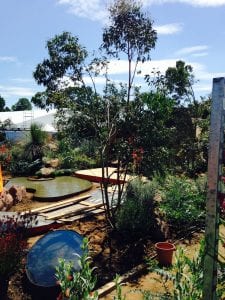Expertise from the University of Lincoln has once again contributed to a win at one of the world’s most prestigious flower shows.
The Essence of Australia garden, which Dr Duncan Rowland from Lincoln’s School of Computer Science worked on, won a Gold Medal and Best in Show at the RHS Hampton Court Palace Flower Show.
Dr Rowland’s research into how Twitter can be used to control and affect external objects was used to regulate a water feature within the garden.
This follows the University of Lincoln’s Gold win at the RHS Chelsea Flower Show in 2013. The unique Twitter-controlled garden, Digital Capabilities responded to live Twitter activity, enabling the public to directly influence how the garden appeared at any one time.
That project was a cross-disciplinary collaboration between academics from the University’s School of Computer Science, School of Psychology and School of Architecture together with designers Harfleet & Harfleet.
The inspirational Essence of Australia garden was designed by the Australian landscape designer, Jim Fogarty, for the Royal Botanic Gardens Melbourne in partnership with Tourism Victoria, Tourism Northern Territory, Qantas and leading UK tour operator, Trailfinders.
It tells the story of the Rainbow Serpent, an Aboriginal dreamtime story about a mythical creature that lived underground and created the mountains and the gorges. Visitors can ‘wake up’ the serpent by tweeting #EssenceOfAus. The presence of water in the Australian landscape is also an integral part of the design.
The garden celebrates Australian flora and contemporary design, evoking the relaxed feel of Australia and Australians’ love of outdoor living as well as celebrating the states and gardening landscapes of Victoria and Northern Territory as two key travel destinations for British holidaymakers.
Dr Rowland’s primary research interests focus on engaging in creative practice to explore the human condition via relationships with digital devices and more traditional media.
He said: “It was fantastic to see Twitter activity controlling the water feature, which represented the waking of the mythical serpent. But what is also nice on a personal level is that the curiosity-driven research I initially did on interfacing and Twitter has had such immediate utility. I began by simply turning my desk lamp on and off with Tweets and set up a Tweet-able webcam in my office window. The work developed and was then included in the Digital Capabilities garden last year.
“It’s great to be able to evidence the value of blue-sky research at Lincoln and it has been an honour to work with such well-respected horticultural talents again.”
Dr Rowland’s research is also used in the University’s STAN (Science Technology Architecture Networks) research project, which is exploring whether architecture is able to reflect and map human emotions.
The STAN garden, which is controlled by people’s responses via Twitter, consists of an articulating raw steel structure that continuously transforms itself.
It has already appeared at the Garden Up horticultural event in Sheffield and the Lincolnshire Show.
